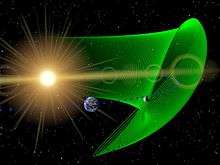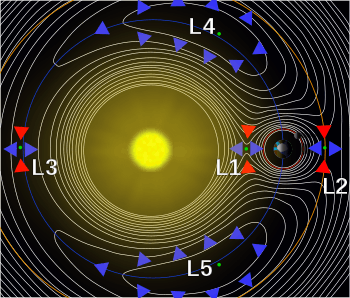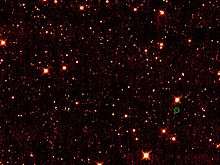Earth trojan


An Earth trojan is an asteroid that orbits the Sun in the vicinity of the Earth–Sun Lagrangian points L4 (leading 60°) or L5 (trailing 60°), thus having an orbit similar to Earth's. Only one Earth trojan has so far been discovered. The name trojan was first used in 1906 for the Jupiter trojans, the asteroids that were observed near the Lagrangian points of Jupiter's orbit.
Members

- Current
L4 (leading)
- 2010 TK7: A 150 to 500-metre-diameter asteroid, discovered using the Wide-field Infrared Survey Explorer (WISE) satellite, is the only confirmed Earth trojan as of 2017.[1][2][3]
L5 (trailing)
- No known objects are currently thought to be L5 trojans of Earth.
Discovery
2010 TK7 was discovered using the Wide-field Infrared Survey Explorer (WISE) satellite, on January 25, 2010.
In February 2017, the OSIRIS-REx spacecraft performed a search from within the L4 region on its way to asteroid Bennu.[4] No additional Earth trojans were discovered.[5]
In April 2017, the Hayabusa 2 spacecraft searched the L5 region while proceeding to asteroid Ryugu,[6] but did not find any asteroids there.[7]
Significance
The orbits of any Earth trojans could make them less energetically costly to reach than the Moon, even though they will be hundreds of times more distant. Such asteroids could one day be useful as sources of elements that are rare near Earth's surface. On Earth, siderophiles such as iridium are difficult to find, having largely sunk to the core of the planet shortly after its formation. A small asteroid could be a rich source of such elements even if its overall composition is similar to Earth's; because of their small size, such bodies would lose heat much more rapidly than a planet once they had formed, and so would not have melted, a prerequisite for differentiation (even if they differentiated, the core would still be within reach). Their weak gravitational fields also would have inhibited significant separation of denser and lighter material; a mass the size of 2010 TK7 would exert a surface gravitational force of less than 0.00005 times that of Earth (although the asteroid's rotation could cause separation).
A hypothetical planet-sized Earth trojan the size of Mars, given the name Theia, is thought by proponents of the giant-impact hypothesis to be the origin of the Moon. The hypothesis states that the Moon formed after Earth and Theia collided,[8] showering material from the two planets into space. This material eventually accreted around Earth and into a single orbiting body, the Moon.
At the same time, material from Theia mixed and combined with Earth's mantle and core. Supporters of the giant-impact hypothesis theorise that Earth's large core in relation to its overall volume is as a result of this combination.
Other companions of Earth
Several other small objects have been found on an orbital path associated with Earth. Although these objects are in 1:1 orbital resonance, they are not Earth trojans, because they do not librate around a definite Sun–Earth Lagrangian point, either L4 or L5.
Earth has another noted companion, asteroid 3753 Cruithne. About 5 km across, it has a peculiar type of orbital resonance called an overlapping horseshoe, and is probably only a temporary liaison.[9]
2016 HO3, an asteroid discovered on 27 April 2016, is possibly the most stable quasi-satellite of Earth.[10]
See also
References
- ↑ Reilly, M. (27 July 2011). "Earth Stalker Found in Eternal Twilight". New Scientist. Retrieved 2014-02-21.
- ↑ Choi, C. Q. (27 July 2011). "First Asteroid Companion of Earth Discovered at Last". Space.com. Retrieved 2011-07-27.
- ↑ https://www.nasa.gov/feature/goddard/2017/osiris-rex-begins-earth-trojan-asteroid-search
- ↑ "NASA mission to search for rare asteroids". NASA. Retrieved 2017-03-01.
- ↑ "OSIRIS-REx Asteroid Search Tests Instruments". NASA. Retrieved 2017-03-24.
- ↑ "太陽−地球系のL5点付近の観測について". JAXA. Retrieved 2017-04-18.
- ↑ "Mission Status of Hayabusa2" (PDF). 49th Lunar and Planetary Science Conference 2018. Retrieved 2018-08-10.
- ↑ "Earth is actually two planets, scientists conclude"
- ↑ Murray, C. (1997). "The Earth's secret companion". Nature. 387 (6634): 651–652. Bibcode:1997Natur.387..651M. doi:10.1038/42585.
- ↑ Agle, DC; Brown, Dwayne; Cantillo, Laurie (15 June 2016). "Small Asteroid Is Earth's Constant Companion". NASA. Retrieved 15 June 2016.
- ↑ "The Theia Hypothesis: New Evidence Emerges that Earth and Moon Were Once the Same". The Daily Galaxy. 2007-07-05. Retrieved 2013-11-13.